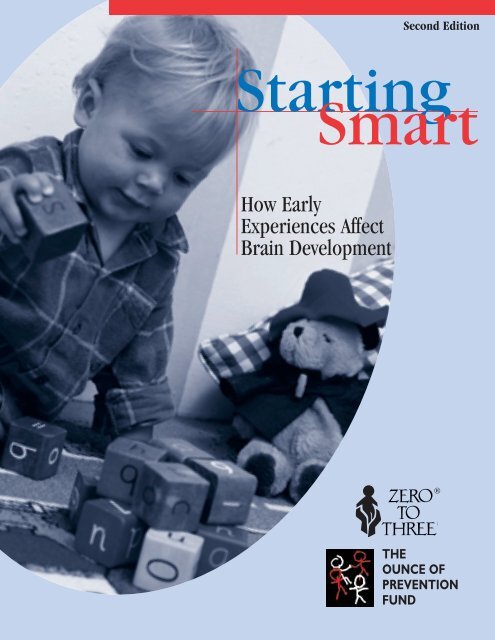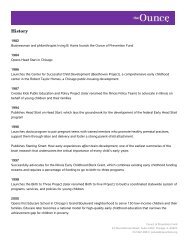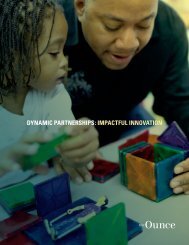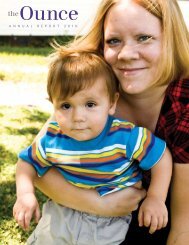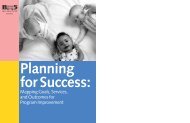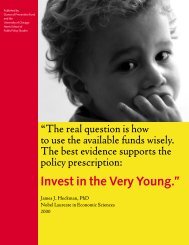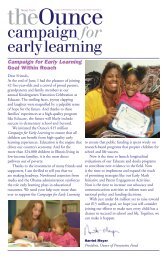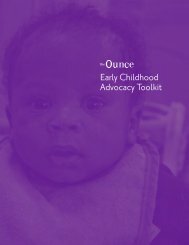How Early Experiences Affect Brain Development - Ounce of ...
How Early Experiences Affect Brain Development - Ounce of ...
How Early Experiences Affect Brain Development - Ounce of ...
You also want an ePaper? Increase the reach of your titles
YUMPU automatically turns print PDFs into web optimized ePapers that Google loves.
Second Edition<br />
Starting<br />
Smart<br />
<strong>How</strong> <strong>Early</strong><br />
<strong>Experiences</strong> <strong>Affect</strong><br />
<strong>Brain</strong> <strong>Development</strong><br />
®<br />
S<br />
THE<br />
OUNCE OF<br />
PREVENTION<br />
FUND
Starting Smart<br />
<strong>How</strong> <strong>Early</strong> <strong>Experiences</strong> <strong>Affect</strong><br />
<strong>Brain</strong> <strong>Development</strong><br />
Michael Stevens is a healthy, beautiful newborn baby. As his<br />
parents admire him, they wonder, "What will Michael be like<br />
when he grows up Will he do well in school Will he get along<br />
with other kids and be happy" Scientists now believe that the<br />
answers to these questions depend in large part on how young<br />
Michael’s brain develops, and that this development in turn depends<br />
largely on the nutritional, medical, emotional, and intellectual support<br />
his parents, extended family, and community provide for him during<br />
his childhood.<br />
Recent advances in brain research have provided great insight into how the brain,<br />
the most immature <strong>of</strong> all organs at birth, continues to grow and develop after birth.<br />
Whereas this growth had been thought to be determined primarily by genetics, scientists now<br />
believe that it is also highly dependent upon the child’s experiences. Research shows that, like protein, fat,<br />
and vitamins, interactions with other people and objects are vital nutrients for the growing and developing brain,<br />
and different experiences can cause the brain to develop in different ways. It is this "plasticity" <strong>of</strong> the brain, its<br />
ability to develop and change in response to the demands <strong>of</strong> the environment, that will enable Michael to learn<br />
how to use computers as successfully as his ancestors learned how to hunt animals in the wild.<br />
As he grows, Michael’s ability to understand language, solve problems, and get along with other people will be<br />
influenced by what he experiences as an infant and young child. This is not to say that individual genetic differences<br />
have no influence on how a child develops; they do. But there is mounting evidence that experiences affect the way<br />
genes are expressed (i.e., turned on and <strong>of</strong>f) in the developing brain. While good early experiences help the brain to<br />
develop well, experiences <strong>of</strong> neglect and abuse can literally cause some genetically normal children to become<br />
mentally retarded or to develop serious emotional difficulties.
Understanding <strong>How</strong> the <strong>Brain</strong> Develops<br />
To understand how this happens, we need to understand a bit about how the brain works. The brain is<br />
comprised <strong>of</strong> many regions that perform specific functions, such as identifying what we see, processing spoken<br />
language, or assessing whether we are in danger. Within each <strong>of</strong> these brain areas are millions <strong>of</strong> neurons, or<br />
nerve cells, which send messages to each other across synapses. These trillions <strong>of</strong> nerves and synapses and the<br />
pathways they form make up the "wiring" <strong>of</strong> the brain; they allow all <strong>of</strong> the various areas to communicate and<br />
function together in a coordinated way. The number and organization <strong>of</strong> connections in the brain influence<br />
everything from the ability to recognize letters <strong>of</strong> the alphabet to facility at managing complex social relationships.<br />
In most regions <strong>of</strong> the brain, no new neurons are formed after birth. Instead, brain development consists <strong>of</strong> an<br />
ongoing process <strong>of</strong> wiring and re-wiring the connections among neurons. New synapses between cells are constantly<br />
being formed, while others are broken or pruned away. This happens throughout life. <strong>How</strong>ever, in early<br />
childhood the brain is genetically programmed to produce more synapses than it will ultimately use. Indeed, by<br />
8 months <strong>of</strong> age a baby may have an astounding 1,000 trillion synapses in his brain! This blooming <strong>of</strong> synapses<br />
happens at different times in different areas <strong>of</strong> the brain. <strong>Development</strong> then proceeds by keeping the synapses<br />
that are used and pruning away those that aren’t. The pruning <strong>of</strong> synapses happens over the childhood years as<br />
the different areas <strong>of</strong> the brain develop(Huttenlocher & Dabholkar, 1997).<br />
Pruning allows the brain to keep the connections that have a purpose, while eliminating those that aren’t doing<br />
anything. In short, pruning increases the efficiency with which the brain can do what it needs to do. But, because<br />
the brain operates on the "use it or lose it" rule, an "over-pruning" <strong>of</strong> these connections can occur when a child<br />
is deprived <strong>of</strong> normally expected experiences in the early years. This leaves the child struggling to do what<br />
would have come more naturally otherwise.<br />
Some areas <strong>of</strong> the brain, such as those which help us see clearly, become less "plastic" or changeable when the<br />
pruning is over. This has led to tremendous concern about providing what the brain needs to prune and organize<br />
itself correctly before the "windows <strong>of</strong> opportunity" close. For example, surgeons now remove congenital<br />
cataracts as early in infancy as possible, because they know that if they wait until the child is older, the neural<br />
connections between his eyes and his brain will fail to develop properly, and he will never be able to see. <strong>Brain</strong><br />
scientists are also working diligently to unlock the secrets <strong>of</strong> how the brain turns on and <strong>of</strong>f its ability to change<br />
itself. There is real hope that if we can understand the ways this happens, we can create therapies, both those<br />
that use drugs and those that use carefully structured experiences and training exercises, that can open up<br />
windows and re-wire brains that were deprived <strong>of</strong> normally expected experiences early in life or those that get<br />
damaged later in life.<br />
Starting<br />
Smart
The Power <strong>of</strong> <strong>Early</strong> <strong>Experiences</strong><br />
Our brains shape and reshape themselves in ways that depend on what we use them for throughout our lives.<br />
Learning language is a nice example <strong>of</strong> how experiences contribute to each person’s unique pattern <strong>of</strong> brain<br />
development. The ability to speak and to understand other’s speech requires only the minimal opportunity to<br />
communicate that almost all children experience. <strong>How</strong>ever, which language a child learns to speak depends<br />
on the language he experiences, and his brain will adapt to this specific language. When an infant is 3 months<br />
old, his brain can distinguish several hundred different spoken sounds, many more than are present in his<br />
native language. Over the next several months, however, his brain will organize itself more efficiently so that<br />
it only recognizes those spoken sounds that are part <strong>of</strong> the language that he regularly hears. For example, a<br />
one-year-old Japanese baby will not recognize that "la" is different from "ra," because the former sound is never<br />
used in his language. During early childhood, the brain retains the ability to re-learn sounds it has discarded,<br />
so young children typically learn new languages easily and without an accent. After about age 10, however,<br />
plasticity for this function is greatly diminished; therefore, most people find it difficult to learn to speak a<br />
foreign language as well as a native speaker if they only begin to learn it in adolescence or adulthood.<br />
More importantly, early experiences can determine how pr<strong>of</strong>icient a child becomes in his or her native language.<br />
Researchers found that when mothers frequently spoke to their infants, their children learned almost 300 more<br />
words by age 2 than did their peers whose mothers rarely spoke to them (Huttenlocher et al., 1991; also, Hart<br />
& Risley, 1995). Furthermore, studies have suggested that mere exposure to language such as listening to the<br />
television or to adults talking amongst themselves provides little benefit. Rather infants need to interact directly<br />
with other human beings, to hear people talking about what they are seeing and experiencing, in order for them<br />
to develop optimal language skills. Unfortunately, many parents are under the mistaken impression that talking<br />
to babies is not very important because they are too young to understand what is being said.<br />
A new consensus is emerging about the importance <strong>of</strong> intervening with families <strong>of</strong> disadvantaged children in the<br />
first months and years <strong>of</strong> life to ensure they provide the kinds <strong>of</strong> experiences that support optimal development.<br />
Psychologists have long known that children <strong>of</strong> poorly educated, low-income parents <strong>of</strong>ten don’t reach the same<br />
intellectual levels as children <strong>of</strong> well-educated, wealthy parents. The recent developments in brain research have<br />
provided new insights into why this is so. Parents who are preoccupied with a daily struggle to ensure that their<br />
children have enough to eat and are safe from harm may not have the resources, information, or time they need<br />
to provide the stimulating experiences that foster optimal brain development. Infants and children who are<br />
rarely spoken to, who are exposed to few toys, and who have little opportunity to explore and experiment with<br />
their environment may fail to fully develop the neural connections and pathways that facilitate later learning.<br />
Despite their normal genetic endowment, these children are at a significant intellectual disadvantage and are<br />
likely to require costly special education or other remedial services when they enter school. Fortunately, intervention<br />
programs that start working with children and their families at birth or even prenatally can help prevent<br />
this tragic loss <strong>of</strong> potential (see box below).<br />
Starting<br />
Smart
Intervention Can Help Kids Who Are at Risk<br />
Through the University <strong>of</strong> North Carolina’s "Abecedarian Project," Craig Ramey and his colleagues demonstrated that<br />
intensive early intervention could greatly enhance the development <strong>of</strong> children whose mothers have low income and<br />
education levels. The children in the project were randomly assigned to receive either an intensive 5-year program <strong>of</strong><br />
full-day, full-year child care and parent involvement activities beginning in the first few months after the child’s birth, or<br />
to receive only free formula and diapers. After just 3 years, dramatic results were evident: the program children had an<br />
average IQ score <strong>of</strong> 105, while the control group children averaged only 85. And unlike many programs which began<br />
intervention at age 4, the effects <strong>of</strong> the program on IQ held over time. The program children were less likely to repeat a<br />
grade in school and demonstrated better achievement in reading and mathematics throughout elementary and high<br />
school. At age 21, the children who participated in the 5-year program still displayed a significant intellectual advantage<br />
over the control children. Clearly this intensive, early intervention had a long-lasting impact on these children’s lives<br />
(Ramey, Campbell, & Blair, 1998).<br />
Emotional <strong>Development</strong> and the Infant <strong>Brain</strong><br />
One <strong>of</strong> the most fundamental tasks an infant undertakes is determining<br />
whether and how he can get his needs met in the world in which he lives.<br />
He is constantly assessing whether his cries for food and comfort are ignored<br />
or lovingly answered, whether he is powerless or can influence what adults<br />
do. If the adults in his life respond predictably to his cries and provide<br />
for his needs, the infant will be more likely to use these adults as<br />
sources <strong>of</strong> safety and security. With his safety taken care <strong>of</strong>, he then<br />
can focus his attention on exploring, allowing his brain to take in all<br />
the wonders <strong>of</strong> the world around him. If, however, his needs are met<br />
only sporadically and pleas for comfort are usually ignored or met<br />
with harsh words and rough handling, the infant will focus his<br />
energies on ensuring that his needs are met. He will have more<br />
and more difficulty interacting with people and objects in his environment,<br />
and his brain will shut out the stimulation it needs to<br />
develop healthy cognitive and social skills (Lieberman & Zeanah,<br />
1995).<br />
Children who receive sensitive, responsive care from their parents<br />
and other caregivers in the first years <strong>of</strong> life enjoy an important<br />
head start toward success in their lives. The secure relationships<br />
they develop with the important adults in their lives lay the foundation<br />
for emotional development and help protect them from the many<br />
stresses they may face as they grow. Researchers who have examined<br />
the life histories <strong>of</strong> children who have succeeded despite many challenges<br />
in their lives consistently found that these people have had at least<br />
one stable, supportive relationship with an adult (usually a parent, relative,<br />
or teacher) beginning early in life (Werner & Smith, 1992).
The Effects <strong>of</strong> Trauma and Chronic Stress<br />
Negative early experiences can also pr<strong>of</strong>oundly affect the development <strong>of</strong> the brain. Unfortunately, child abuse and neglect are pervasive<br />
social problems. Each year in the United States there are more than a million substantiated cases – and many more than that<br />
probably never come to light. Maltreatment increases a child’s risk <strong>of</strong> developing depression, self-destructive behavior, eating disorders,<br />
attention deficit disorders, drug and alcohol problems, sexual promiscuity, and delinquency. Many researchers believe that these<br />
effects can be partly explained by understanding how chaotic, stressful, and traumatic experiences affect brain development.<br />
<strong>How</strong>ever, this is a new area <strong>of</strong> study, with much more that we need to learn.<br />
At the moment, we know the most about how traumatic experiences affect the brains <strong>of</strong> children who develop Post-Traumatic Stress<br />
Disorder (PTSD) (see box below). Similar to adults with PTSD, these children have trouble sleeping, can’t control their memories<br />
<strong>of</strong> the trauma, and seem to be on constant alert (Kaufman & Charney, 1999). Estimates vary from as low as 30% to as high as 90%<br />
for the likelihood <strong>of</strong> developing PTSD for some period following sexual and physical abuse in childhood – and it can have long-lasting<br />
effects (Fletcher, 1996). While experiencing the symptoms <strong>of</strong> PTSD, children have difficulty learning and maintaining positive<br />
relationships with family and peers. Although the ability <strong>of</strong> the brain to put abused children on constant alert may help them to<br />
survive in traumatic environments (for example, the battered child may be able to better avoid the abusive father when he is in a<br />
bad mood) it exacts a cost, for the child and for society.<br />
It is important that we not assume that a poorly parented or traumatized child is incapable <strong>of</strong> healthy functioning later in childhood<br />
or adolescence. Research on the developing brain suggests continuing opportunity for change into adulthood and provides no<br />
evidence that there is some age beyond which intervention will fail to make a difference. In fact, this research provides exciting new<br />
clues as to what kinds <strong>of</strong> therapy might be most helpful for children who have experienced difficult lives (DeBellis, Baum et al.,<br />
1999; DeBellis, Keshaven, et al., 1999). Clearly, however, the costs (in human suffering, loss <strong>of</strong> potential, and real money) <strong>of</strong> trying<br />
to repair, remediate, or heal these children is far greater than the costs <strong>of</strong> preventing these problems by promoting healthy<br />
development <strong>of</strong> the brain during the first few years <strong>of</strong> life.<br />
The Impact <strong>of</strong> Neglect and Trauma on the Developing <strong>Brain</strong>:<br />
<strong>How</strong> Nurture Becomes Nature<br />
At the <strong>Development</strong>al Traumatology Laboratory at Western Psychiatric Institute and Clinics in Pittsburgh,<br />
Pennsylvania, researchers are conducting studies in traumatized children using the most up-to-date methods to study<br />
their stress circuits and brain development. In a recent report, they described their findings on maltreated children<br />
with PTSD who they compared to healthy, normal children and to children with clinical anxiety disorders who had<br />
not been maltreated. Many <strong>of</strong> the maltreated children had been sexually abused beginning between the ages <strong>of</strong> 18<br />
months and 7 years. They had also witnessed domestic violence beginning early in life, and some had been battered<br />
by family members. For most <strong>of</strong> the children with PTSD, the trauma was chronic, lasting for several years before the<br />
children were rescued.<br />
Unlike non-maltreated comparison children, the children with PTSD had elevated levels <strong>of</strong> the stress hormones adrenaline<br />
and cortisol, even on a normal day when nothing especially stressful was happening (DeBellis, Baum, et al., 1999). Thus, these<br />
children’s stress systems seemed to be turned on even when they didn’t need to be. Especially high stress hormone levels were<br />
found among the children who had been abused for longer and/or had more severe PTSD. Very similar results have been found for<br />
children rescued from Romanian orphanages, even though for the most part these children had been severely neglected rather than<br />
physically or sexually abused.<br />
The Pittsburgh group also scanned the brains <strong>of</strong> maltreated children with PTSD. Even after they accounted for many things that could<br />
produce mistaken results, they found striking evidence <strong>of</strong> smaller brain volumes, with larger effects the earlier the abuse began and<br />
the longer it lasted before the children were rescued (De Bellis, Keshaven, et al., 1999). Similar results have been found at the CIVI-<br />
TAS Child Trauma Programs at Baylor College <strong>of</strong> Medicine. Did the abuse cause the brains <strong>of</strong> these children to be smaller We can’t<br />
be certain. Would the brains <strong>of</strong> abused children who did not develop chronic PTSD also show some reduction in size We don’t<br />
know. But these data and other studies currently underway certainly encourage concern about the impact that maltreatment may have<br />
on the child’s developing nervous system.
Helping Families Support Healthy <strong>Brain</strong> <strong>Development</strong><br />
It is now clear that what a child experiences in the first years <strong>of</strong> life pr<strong>of</strong>oundly influences how his brain will develop and how he<br />
will interact with the world throughout his life. Parents play the most important role in providing the nurturing and stimulation<br />
that children require, but they need information and support to develop good parenting skills. In the past, extended family<br />
members were <strong>of</strong>ten close by, <strong>of</strong>fering good advice and acting as role models for inexperienced parents. Young families today<br />
<strong>of</strong>ten live far away from grandparents and other family and rely more on community resources for information and support in<br />
parenting. There is much that communities can do to help families promote their children’s healthy brain development.<br />
Educate parents about the importance <strong>of</strong> early experiences for their children’s development.<br />
Often parents don’t know about the many little things they can do to foster their children’s healthy cognitive and emotional<br />
development, like talking to the children beginning in infancy, reading to them from a very early age, and helping them play<br />
simple games. Parents, especially new or young parents, may also need help learning to recognize their children’s cues that<br />
they are hungry for stimulation or have had enough.<br />
In some cases written materials or a few sessions <strong>of</strong> parenting education classes may be all that a parent needs to learn how to<br />
provide his or her child with appropriate stimulation. <strong>How</strong>ever, parenting styles and beliefs that have<br />
evolved over generations—such as rarely talking to babies—can be difficult for parents<br />
to change. Many parents benefit from community-based programs in which a parent<br />
group leader or a home visitor acts as a role model and coach, supporting parents<br />
in their relationships with their children. Programs that work with parents<br />
over several years can be very successful in helping them become effective<br />
"first teachers" <strong>of</strong> their children (Olds et al, 1993).<br />
Prevent abuse and neglect.<br />
Children who are abused or severely neglected are at extremely<br />
high risk <strong>of</strong> developing emotional, behavioral, social, and intellectual<br />
disabilities. By the time a child is identified as having been<br />
neglected or abused, these problems have already begun to<br />
develop. Greater attention must be given to preventing maltreatment<br />
before it starts. High-quality home visiting programs that<br />
start working with families as soon as the child is born have<br />
proven to be effective in preventing abuse and neglect (MacMillan<br />
et al., 1994). The key to these programs’ success is that they help<br />
parents manage the stresses <strong>of</strong> raising children before unhealthy<br />
patterns develop and things get out <strong>of</strong> control.<br />
Starting<br />
Smart
Provide accessible, quality mental health services for parents.<br />
Research has shown that parents suffering from untreated depression <strong>of</strong>ten fail<br />
to respond sensitively to their children’s cries and bids for attention, and that<br />
they are unlikely to provide the child with the kind <strong>of</strong> cognitive stimulation<br />
that promotes healthy brain development (Field, 1995). Other mental illnesses,<br />
such as schizophrenia, can also dramatically affect a parent’s<br />
ability to interact appropriately with his or her child. Proper mental<br />
health treatment for these parents can make a real difference in their<br />
ability to raise a competent, well-adjusted child.<br />
Ensure adequate nutrition prenatally and in the<br />
first years after birth.<br />
Numerous studies have shown the devastating effects on intelligence<br />
and brain development <strong>of</strong> a lack <strong>of</strong> basic nutrients in the prenatal<br />
period, in infancy and in early childhood. Programs such as the<br />
Special Supplemental Program for Women, Infants, and Children<br />
(WIC) can be effective in ensuring that babies receive the kinds <strong>of</strong><br />
foods they need to thrive (Yip et al., 1987). Educational and outreach<br />
campaigns to alert women to the importance <strong>of</strong> nutrition in the first<br />
trimester <strong>of</strong> pregnancy would also be helpful in preventing problems<br />
that can arise in this critical period when brain cells begin to form.<br />
Starting<br />
Smart<br />
The Importance <strong>of</strong> Quality in Infant-Toddler Child Care<br />
Increasing numbers <strong>of</strong> U.S. infants and toddlers spend hours each day in various child care arrangements<br />
because their parents work or attend school. It is critical that the care that these children receive promotes<br />
their healthy growth and development. Too <strong>of</strong>ten, however, child care providers are poorly trained and do not<br />
provide children with appropriate stimulation. Research has shown that in the majority <strong>of</strong> infant care arrangements<br />
in the U.S., children are not talked to and played with enough, and they do not have the opportunity to<br />
form the kind <strong>of</strong> comfortable, secure relationships with a caregiver who will promote their healthy emotional<br />
development (The Cost, Quality and Child Care Outcomes Study Team, 1995; National Center for <strong>Early</strong><br />
<strong>Development</strong> and Learning, 1999).<br />
Parents should be given information about how to choose quality care for their children. In addition, special<br />
attention must be given to the development and enforcement <strong>of</strong> child care licensing standards that promote<br />
high-quality care: adequate pre-service and inservice training for caregivers; low child-to-teacher ratios, and<br />
small group sizes. Finally, child care reimbursement rates for families moving from welfare to work must be<br />
high enough to fund well-trained teachers who can deliver developmentally appropriate care and education.
Conclusion<br />
Like most children, Michael Stevens has a family who will provide the stimulation and nurturing that he needs to<br />
grow and develop to his potential. Unfortunately, high rates <strong>of</strong> child abuse and neglect across the country as well as<br />
persistently high rates <strong>of</strong> school failure in some communities indicate that far too many children do not receive what<br />
they need during their first few years for healthy brain growth and development. As our society becomes even more<br />
technically and socially complex, we cannot afford to continue to allow large numbers <strong>of</strong> children to miss out on the<br />
positive experiences they need in infancy and early childhood; the costs, in terms <strong>of</strong> lost intellectual potential and<br />
increased rates <strong>of</strong> emotional and behavioral problems, are too high. The new developments in brain research show<br />
us what children need; our challenge is to ensure that every child receives it.<br />
Recommended Reading<br />
Shore, R. (1997).<br />
Rethinking the brain. New York: Families and Work Institute.<br />
Kotulak, R. (1996).<br />
Inside the brain. Kansas City: Andrews and McMeel.<br />
Barnet, A. B., & Barnet, R. J. (1998).<br />
The youngest minds: Parenting and genes in the<br />
development <strong>of</strong> intellect and emotion. New York: Simon & Schuster.<br />
Gopnik, A., Meltz<strong>of</strong>f, A. N., & Kuhl, P. K. (1999).<br />
The scientist in the crib: Minds, brains,<br />
and how children learn. New York: Morrow.<br />
Harris, I. B. (1996).<br />
Children in jeopardy: Can we break the cycle <strong>of</strong> poverty New Haven, CT:<br />
Yale Child Study Center.<br />
Ramey, C., & Ramey, S. (1998).<br />
<strong>Early</strong> intervention and early experience. American Psychologist, 53, 109-120.<br />
ZERO TO THREE: (1992).<br />
Heart start: The emotional foundations <strong>of</strong> school readiness. Arlington, VA: Author.
References<br />
The Cost, Quality and Child Care Outcomes Study Team. (1995). Cost, quality, and child care outcomes in child<br />
care centers. Denver: University <strong>of</strong> Colorado at Denver, Economics Department.<br />
De Bellis, M. D., Bum, A. S., Birmaher, B., Keshavan, M. S., Eccard, C. H., Boring, A. M., Jenkins, F. J., & Ryan, N.<br />
D. (1999). <strong>Development</strong>al traumatology. Part 1: Biological stress systems. Biological Psychiatry, 45, 1259-1270.<br />
De Bellis, M. D., Keshaven, M. S., Clark, D. B., Caseey, B. J., Giedd, J. B., Boring, A. M., Frustaci, K., & Ryan, N. D.<br />
(1999). <strong>Development</strong>al traumatology. . Part 2: <strong>Brain</strong> development. Biological Psychiatry, 45, 1271-1284.<br />
Field, T. M. (1995). Psychologically depressed parents. In M. H. Bornstein (Ed.), Handbook <strong>of</strong> parenting: Vol. 4.<br />
Applied practical parenting (pp. 85-107). Mahwah, NJ: Lawrence Erlbaum Associates, Inc.<br />
Fletcher, K. E. (1996). Childhood postraumatic stress disorder. In E. H. Mash & R. A. Barkley (Eds.), Child<br />
Psychopathology (pp. 242-276). New York: Guildford Publications, Inc.<br />
Hart, B., & Risley, T. R. (1995). Meaningful differences in the everyday experience <strong>of</strong> young American<br />
children. Baltimore: Brookes Publishing.<br />
Huttenlocher, J., Haight, W., Bryk, A., Seltzer, M., & Lyons, T. (1991). <strong>Early</strong> vocabulary growth: Relation to language<br />
input and gender. <strong>Development</strong>al Psychology, 27, 236-248.<br />
Huttenlocher, P. R., & Dabholkar, A. S. (1997). Regional differences in synaptogenesis in the human cerebral<br />
cortex. Journal <strong>of</strong> Comparative Neurology, 387, 167-178.<br />
Kaufman, J., & Charney, D. S. (1999). Neurobiological correlates <strong>of</strong> child abuse. Biological Psychiatry, 45,<br />
1235-1236.<br />
Lieberman, A. F., & Zeanah, H. (1995). Disorders <strong>of</strong> attachment in infancy. Infant Psychiatry, 4, 571-587.<br />
MacMillan, H. L., MacMillan, J. H., Offord, D. R., Griffith, L., & MacMillan, A. (1994). Primary prevention <strong>of</strong><br />
child physical abuse and neglect: A critical review. Part I. Journal <strong>of</strong> Child Psychology and Psychiatry and Allied<br />
Disciplines, 35, 835-856.<br />
National Center for <strong>Early</strong> <strong>Development</strong> and Learning. (1999). The children <strong>of</strong> the Cost, Quality and Outcomes<br />
Study go to school. Chapel Hill, NC: Frank Porter Graham Child <strong>Development</strong> Center.<br />
Olds, D. L., Henderson, C. R. Jr., Phelps, C., Kitzman, H., & Hanks, C. (1993). Effect <strong>of</strong> prenatal and infancy nurse<br />
home visitation on government spending. Medical Care, 31(2) 155-174.<br />
Ramey, C., Campbell, F., & Blair, C. (1998). Enhancing the life course for high-risk children. In J. Crane (Ed.),<br />
Social programs that work (pp. 184-199). New York: Russell Sage Foundation. [Note: Additional statistics cited<br />
on the Abecedarian Project’s Web site at http://www.fpg.unc.edu/verity/]<br />
Werner, E. E., & Smith, R. S. (1992). Overcoming the odds: High risk children from birth to adulthood. Ithaca,<br />
NY: Cornell University Press.<br />
Yip, R., Binkin, N. J., Fleshood, L, & Trowbridge, F. L. (1987). Declining prevalence <strong>of</strong> anemia among low-income<br />
children in the United States. Journal <strong>of</strong> the American Medical Association, 258(12), 1619-1623.<br />
Starting<br />
Smart
Starting<br />
Smart<br />
Credits<br />
Author: Theresa Hawley, Ph.D., with contributions by Megan Gunner, Ph.D.<br />
Photo credits: Pages 2, 5, and 8—© Marilyn Nolt<br />
Pages 6 and 7—© Harry Cutting Photography<br />
Page 9—© Ross Whitaker, New York, NY<br />
Copyright 2000 <strong>Ounce</strong> <strong>of</strong> Prevention Fund and ZERO TO THREE.<br />
All rights reserved.<br />
ISBN 0-943657-48-2
®<br />
S<br />
734 15th Street, NW, Suite 1000<br />
Washington, DC 20005-1013<br />
202.638.1144 voice<br />
202.638.0851 fax<br />
800.899.4301 orders<br />
www.zerotothree.org<br />
THE<br />
OUNCE OF<br />
PREVENTION<br />
FUND<br />
122 South Michigan Avenue, Suite 2050<br />
Chicago, Illinois 60603-6107<br />
312.922.3863 voice<br />
312.922.3337 fax<br />
www.ounce<strong>of</strong>prevention.org


